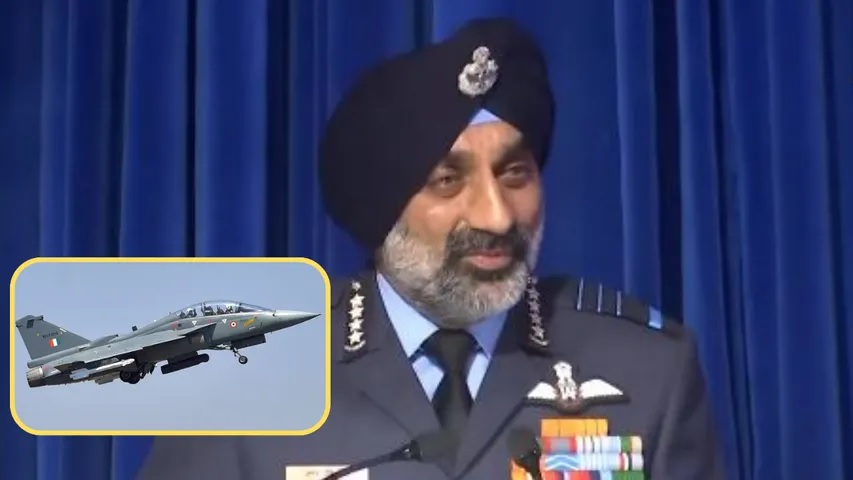Still waiting for 40 Tejas jets that were ordered in 2010': IAF chief

India’s security landscape is growing increasingly complex, with heightened challenges along its borders with China and Pakistan. At the 21st Subroto Mukherjee Seminar in New Delhi, Indian Air Force (IAF) Chief Air Chief Marshal A.P. Singh expressed serious concerns about the country’s preparedness in the face of rapid militarisation by its neighbours. He pointed to delays in critical indigenous defence projects, particularly the much-anticipated Tejas fighter jets, as a significant bottleneck.
The Long Wait for Tejas Jets
Over a decade has passed since the IAF placed an order for 40 Tejas Mark-1 fighter jets in 2010, yet these aircraft are still not fully delivered. The delay in delivering these jets, powered by the American GE-F404 turbofan engines, has raised concerns about the IAF’s ability to maintain operational readiness. The IAF chief described the pace of indigenous defence production as "too slow," warning that delayed technology is effectively denied technology.
The IAF currently operates only 30 fighter squadrons, far below the sanctioned strength of 42.5 needed to counter dual-front threats from China and Pakistan. The situation underscores the pressing need for timely deliveries of both the 40 ordered Tejas jets and future variants such as the Mark-1A and Mark-2 models. A total of 180 Tejas Mark-1A and 108 Mark-2 jets are planned for induction before the IAF transitions to the Advanced Medium Combat Aircraft (AMCA).
While the Tejas aircraft represents a leap in India’s indigenous capabilities, the slow production and delivery timelines diminish its immediate utility. The IAF has reiterated the urgent need for faster deliveries to address its squadron deficit.
China’s Military Advancements Raise Alarms
India’s delays in defence projects stand in stark contrast to China’s rapid military advancements. China recently revealed two sixth-generation stealth fighter jets during test flights, showcasing its leap ahead in defence technology. These tailless aircraft, featuring cutting-edge stealth capabilities, have stunned global military observers, including the United States, which is still finalising its sixth-generation fighter program.
China’s existing fifth-generation Chengdu J-20 stealth fighters have already been deployed near the Indian border at Hotan and Shigatse airbases, adding further pressure on India to enhance its air combat capabilities.
Indigenous Challenges and Self-Reliance
Despite the government’s push for "Atmanirbhar Bharat" (self-reliant India), the pace of indigenisation in defence remains sluggish. The IAF has taken steps to foster local production, working with MSMEs to produce over 50,000 components for Base Repair Depots. Additionally, initiatives such as the Directorate of Aerospace Design and innovation schemes like iDEX (Innovations for Defence Excellence) aim to strengthen private sector participation.
However, Air Chief Marshal Singh emphasised that self-reliance comes with a cost. Indigenous R&D projects may require higher upfront investments and involve risks and potential failures. He urged policymakers to accept these challenges, highlighting that strategic independence in defence is worth the financial and operational costs.
Looking Ahead: AMCA and Strategic Focus
While Tejas faces delays, India is already working on its next-generation fighter program, the Advanced Medium Combat Aircraft (AMCA). Approved in 2022 with a budget of ₹15,000 crore, the AMCA is expected to feature advanced stealth capabilities and a twin-engine design. The first prototype is slated for testing in four to five years, with production likely to begin after 2035. However, the IAF chief’s remarks highlight the importance of timely execution to ensure that AMCA avoids the delays that have plagued other indigenous programs.
Conclusion
Air Chief Marshal A.P. Singh’s candid observations highlight the urgent need for India to accelerate its indigenous defence projects to maintain a credible deterrence against its adversaries. As China and Pakistan modernise their militaries, India must address delays in critical programmes like Tejas and AMCA while fostering robust private sector partnerships. The path to self-reliance in defence may be challenging, but the strategic benefits far outweigh the costs.



